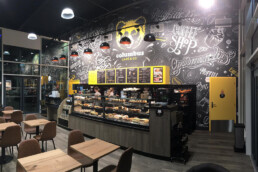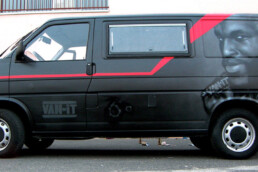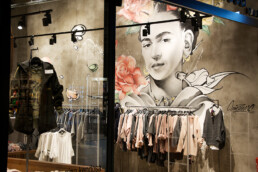A mesmerizing fusion of creativity and commerce is taking place within the realm of fashion retail in Dubai. Picture this: vibrant murals adorning the walls, each stroke telling a unique story of style and self-expression. Step inside these boutique spaces, and you are not just shopping; you are embarking on a visual journey where design innovation meets urban artistry. This intriguing synergy between fashion and street art is not merely about selling clothes—it’s a testament to the power of art in transforming the very essence of the shopping experience. As the sun sets over the cityscape, Dubai’s fashion scene awakens with a burst of color and energy, thanks to the marriage of fashion graffiti and retail spaces. The once-ordinary walls now serve as canvases for creative expressions, blending the boundaries between high-end style and street-wise flair. With every brushstroke, these boutique murals whisper tales of sophistication and urban grit, inviting shoppers to immerse themselves in a world where fashion transcends clothing—it becomes a lifestyle. Join us on a journey through the heart of Dubai’s retail art fusion, where every corner holds the promise of a unique shopping experience that elevates style to a whole new dimension.
Collaborations Between Fashion Designers and Street Artists
In the world of fashion, collaborations have become a powerful tool for brands to expand their reach and connect with new audiences. One such collaboration that has been gaining traction in recent years is the partnership between fashion designers and street artists. This unlikely pairing brings together two distinct art forms – fashion and street art – to create something truly unique and captivating.
When fashion designers collaborate with street artists, they are able to tap into a whole new realm of creativity. Street artists bring their raw, unfiltered talent to the table, infusing fashion designs with a sense of urban edge and rebelliousness. On the other hand, fashion designers provide a platform for these artists to showcase their work on a larger scale, reaching a wider audience than they would on the streets alone.
These collaborations often result in limited-edition collections that blur the lines between art and fashion. Pieces are adorned with bold graffiti prints, vibrant colors, and intricate illustrations – all inspired by the urban landscapes that serve as the backdrop for street art. The result is clothing that not only looks visually stunning but also tells a story.
Impact of Urban Artistry on Consumer Behavior
The integration of street art into fashion retail spaces has had a profound impact on consumer behavior. By incorporating elements of urban artistry into their stores, brands are able to create an immersive shopping experience that goes beyond simply browsing racks of clothing.
When consumers step into a retail space adorned with murals and graffiti, they are transported into a world where creativity knows no bounds. The vibrant colors and bold designs stimulate their senses and evoke emotions that traditional retail spaces simply cannot replicate. This heightened sensory experience not only makes shopping more enjoyable but also creates a lasting impression in the minds of consumers.
In addition to enhancing the overall shopping experience, the presence of street art in retail spaces also helps to establish a sense of authenticity and uniqueness. Consumers are drawn to brands that embrace individuality and self-expression, and the fusion of fashion and street art allows them to connect with these values on a deeper level. By aligning themselves with urban artistry, brands are able to tap into a niche market of consumers who appreciate the intersection of fashion and creativity.
The Role of Murals in Enhancing Brand Identity
One of the most powerful ways in which street art is transforming retail spaces is through the use of murals. These large-scale artworks not only serve as eye-catching focal points but also play a crucial role in enhancing brand identity.
When brands commission artists to create murals for their stores, they are essentially inviting them to become part of their story. The murals become an extension of the brand’s identity, reflecting its values, aesthetics, and personality. This not only helps to differentiate the brand from its competitors but also creates a sense of loyalty among consumers who resonate with its artistic vision.
Furthermore, murals have the ability to attract attention and generate buzz both online and offline. In today’s digital age, where social media plays a significant role in shaping consumer behavior, having an Instagram-worthy mural can be a game-changer for brands. These visually striking artworks become viral sensations, drawing people from all corners of the city to visit the store and experience it for themselves.
Street Art as a Tool for Community Engagement in Retail
Beyond its aesthetic appeal and impact on consumer behavior, street art has also emerged as a powerful tool for community engagement within the realm of fashion retail.
Many brands are using street art as a means to connect with local communities and give back in meaningful ways. By commissioning local artists to create murals or hosting street art events, brands are able to foster a sense of community and support the local arts scene. This not only helps to build positive brand associations but also creates a lasting impact on the neighborhoods in which these retail spaces are located.
Moreover, street art has the ability to spark conversations and ignite social change. By addressing important social issues through their artwork, artists are able to raise awareness and provoke thought among consumers. This creates a sense of purpose and meaning behind the fashion that is being sold, allowing consumers to feel like they are part of something bigger than themselves.
Future Trends: Innovations in Retail Space Design
As the synergy between fashion and street art continues to evolve, so does the design of retail spaces. In the future, we can expect to see even more innovative approaches to incorporating street art into fashion retail.
One trend that is already gaining momentum is the transformation of retail spaces into art galleries. Brands are turning their stores into immersive experiences where customers can not only shop for clothing but also engage with art installations and exhibitions. These hybrid spaces blur the boundaries between fashion and art, creating a dynamic environment that appeals to a wide range of consumers.
Another emerging trend is the use of augmented reality (AR) technology to bring street art to life within retail spaces. Imagine walking into a store and using your smartphone or AR glasses to see virtual graffiti come alive on the walls or watch an animated mural unfold before your eyes. This fusion of digital technology and physical artwork adds another layer of interactivity and engagement for consumers.
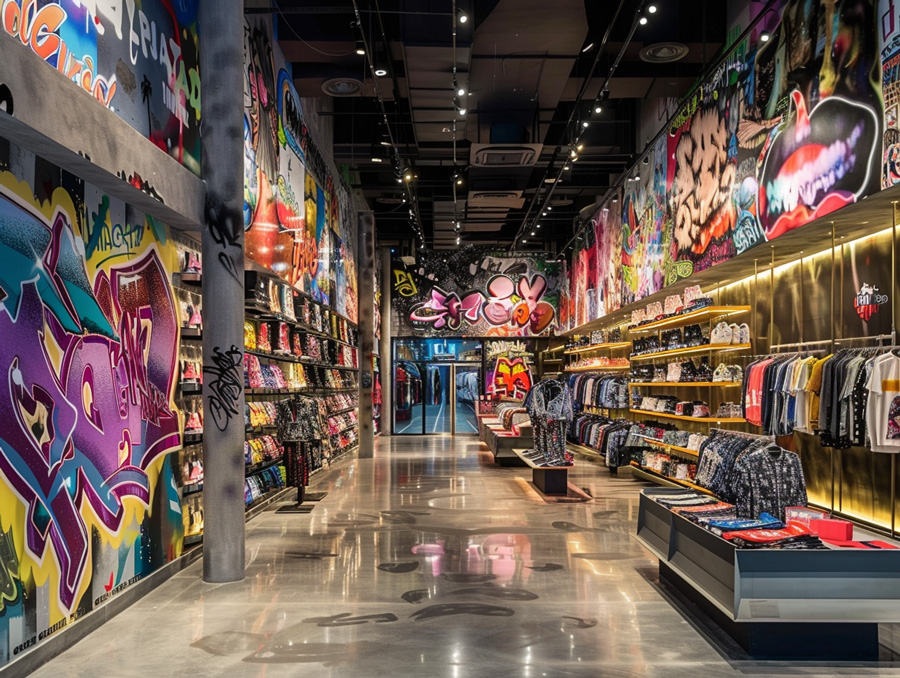 Conclusion: Embracing the Transformative Power of Art in Fashion Retail
Conclusion: Embracing the Transformative Power of Art in Fashion Retail
The integration of street art into fashion retail spaces in Dubai has transformed the way we experience shopping. It has elevated fashion from mere clothing to a form of artistic expression, blurring the boundaries between style and self-expression.
By embracing the transformative power of art, brands are able to create unique and immersive shopping experiences that resonate with consumers on a deeper level. Whether it’s through collaborations between fashion designers and street artists, the use of murals to enhance brand identity, or the engagement of local communities through street art events, the synergy between fashion and street art is shaping the future of retail in Dubai.
Transforming Retail Spaces into Art Galleries
One of the most exciting developments in the fusion of fashion and street art is the transformation of retail spaces into art galleries. This trend takes the concept of experiential shopping to a whole new level by turning stores into immersive art installations.
Instead of simply displaying clothing on racks, brands are now curating their spaces with carefully selected artworks that complement their collections. These artworks can range from large-scale murals to smaller sculptures or installations. The goal is to create an environment where customers can not only shop but also engage with art in a meaningful way.
Walking into one of these transformed retail spaces feels like stepping into a gallery. The walls are adorned with captivating artworks that tell stories and evoke emotions. Customers are encouraged to explore and interact with the artwork, creating a sense of discovery and wonder.
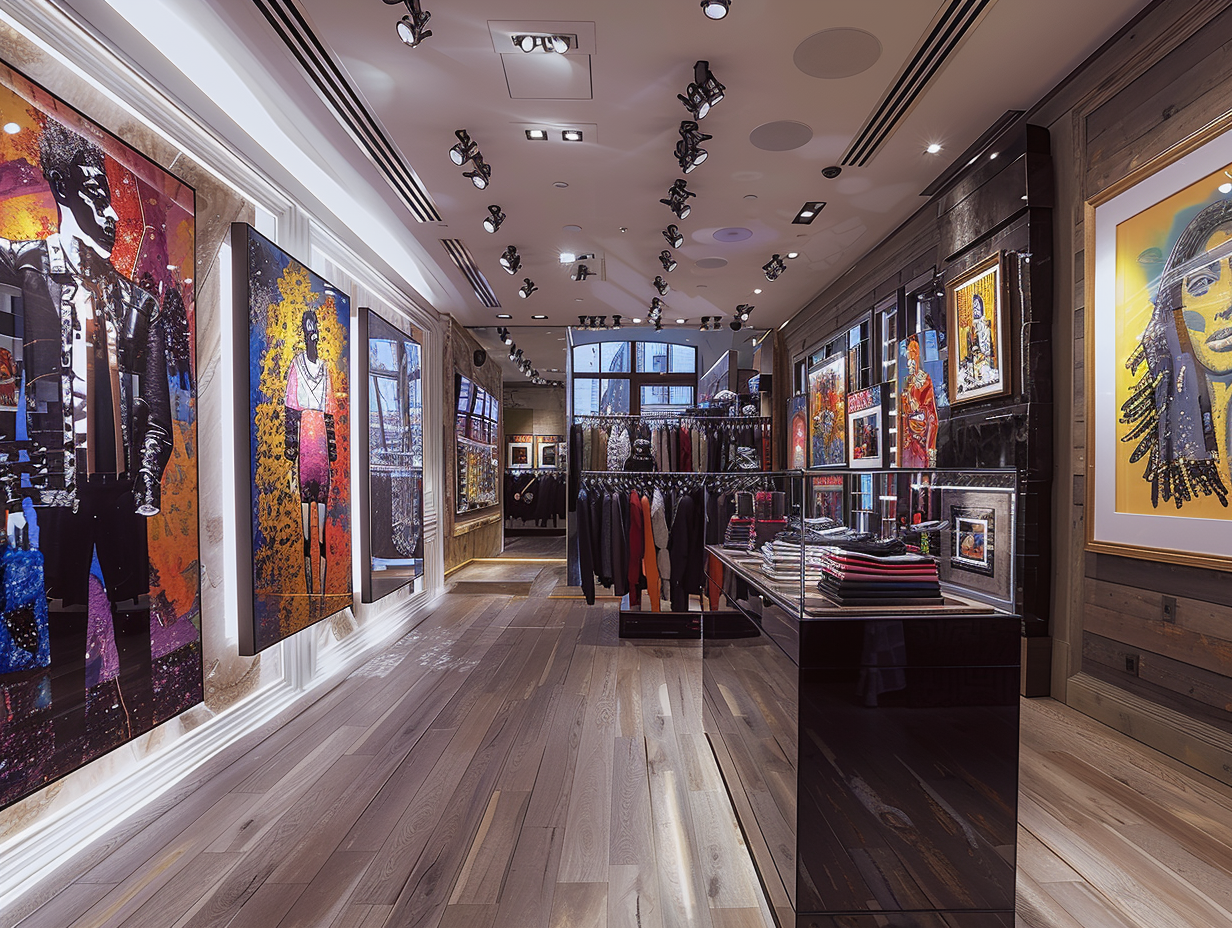
This transformation not only enhances the visual appeal of retail spaces but also elevates the overall shopping experience. Customers no longer feel like they are just buying clothes; they are immersing themselves in a world where fashion and art collide.
In addition to creating a unique shopping experience, transforming retail spaces into art galleries also helps brands differentiate themselves from their competitors. By embracing creativity and artistic expression, brands can attract customers who appreciate these values and want more than just another generic shopping experience.
Furthermore, this trend has the potential to foster collaborations between fashion designers and artists. By showcasing artworks alongside clothing, brands can create opportunities for cross-pollination of ideas and inspiration. This collaboration can result in truly innovative and boundary-pushing designs that push the boundaries of what is considered « fashion. »
In conclusion, transforming retail spaces into art galleries is a trend that is revolutionizing the way we shop. By blending fashion and art, brands are creating immersive experiences that engage customers on a deeper level. This fusion of creativity and commerce not only enhances the visual appeal of retail spaces but also elevates the overall shopping experience.
Related Posts
4 novembre 2023
The Artistic Transformation of Dubai’s Dining Spaces with Graffiti
Dive into Dubai's dining revolution…
17 mai 2023
Transforming food trucks: the power of Street Art in Dubai
In Dubai's bustling food truck scene,…
16 mai 2023
Transforming Dubai Boutiques: The Power of Artistic Wall Decoration
In the vibrant retail landscape of…
